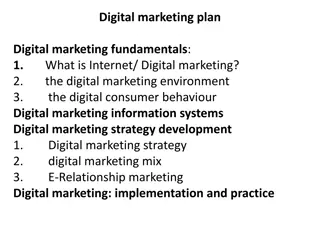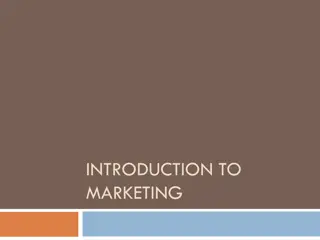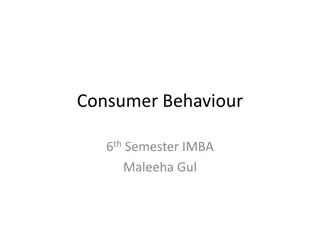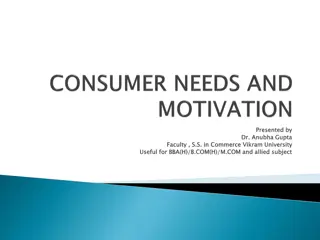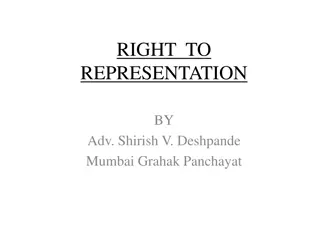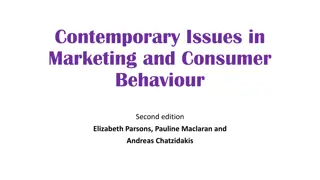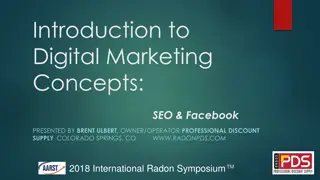Understanding Consumer Behavior in Marketing
The design of a marketing program starts with understanding consumer behavior. Consumers, as the end users, play a crucial role in shaping market trends. Producers seek insights into consumer personas, market behaviors, and influencing factors. Management focuses on the consequences of consumer behavior, both for marketing strategies and societal impacts. Consumer behavior encompasses the actions individuals take in acquiring, using, and disposing of goods and services. Studying consumer behavior helps in comprehending resource allocation decisions and consumption patterns.
Download Presentation

Please find below an Image/Link to download the presentation.
The content on the website is provided AS IS for your information and personal use only. It may not be sold, licensed, or shared on other websites without obtaining consent from the author. Download presentation by click this link. If you encounter any issues during the download, it is possible that the publisher has removed the file from their server.
E N D
Presentation Transcript
Consumer Consumer Behaviour Behaviour
The design of a marketing programme begins with an understanding of consumer behavior. The term consumer refers to the ultimate user of a product (goods and services). This user may be a member of household or industrial firm consumers, which are distinct from the final buyers. Here, the buyers often act only as agents.
Producers are interested in the following Producers are interested in the following What kind of person the consumer is? What behavior does the consumer exhibit in the market place? What influences such behavior?
Those in management are interested in more than the above questions. For example: What are the consequences of the behavior which consumers exhibit for marketing practitioners? What are the consequences of this behavior on the society as a whole? For example, prices increase; price of bread increase, yet people did not stop buying bread or other products, why is this so?
Definition of Consumer Behaviour Definition of Consumer Behaviour According to Engel James et al, Consumer behavior can be defined as those acts of individuals directly involved in obtaining, using and disposing of economic goods and services including the decision process that precedes and determines those acts.
It can also be defined as the behavior that consumers displays in searching for, purchasing, using, evaluating and disposing of products, services and ideas which will satisfy their needs. (According to Schiff man and Kanuk)
The study of consumer behavior is the study of how individuals make decision to spend their available resources (Money, Time, Effort) on consumption related items. It includes the study of what they buy, why they buy it, how they buy it, when they buy it, where they buy it and how often they buy it.
Thus, the study of an individuals consumption behavior in the area of toothpaste products might include a study of why he uses toothpaste, for instance it can be (to whiten his teeth), which brand of toothpaste does he buy? (E.g. Close Up). Why he buys it may be because he believes that it will whiten his teeth better than other competing brands, how he buys it (for cash), when he buys it (when he does the food shopping), where he buys it (in the supermarket) and how often he buys it (approximately every three weeks).
Why we study consumer Behaviour Why we study consumer Behaviour We seek to understand, explain and predict human actions in their consumption role. Consumer behavior is an area of marketing where a large body of knowledge has been accumulated through empirical research, and one of the benefits of studying consumer behavior is having exposure to such knowledge. It is important for marketers to recognize why and how individuals make their consumption decision so that marketers can make better strategy
MODELS OF CONSUMER BEHAVIOUR MODELS OF CONSUMER BEHAVIOUR A model can be defined simply as a means of describing a concept, its causes and its effects. Its basic components are: Input Process Output Models provide framework for analyzing consumer behavior. With the use of models, one can map out the causes or antecedents of a particular behavior and their result or consequence.
Researchers have developed models that describe Consumer decision making. One of such models is the comprehensive Engel, Kollat and Blackwell (EKB) model. Engel, Kollat and Blackwell Model
EKB Model is a multimedia comprehensive model of consumer decision making which maps out the complex mix of factors that affect the simplest consumer decision. EKB shows the components of decision making and also demonstrates the multiple relationships of interactions among the components.
The model takes into account some factors The model takes into account some factors that affects purchase decision that affects purchase decision Economic factor The most important and first on this list is the Economic Factor. This one is the main foundation of any purchasing decision. The reason is simple people can t buy what they can t afford. The need of a product also doesn t play a role here, but the most important thing is affordability.
Functional factor The factor is totally about needs, backed by a logic that what makes sense and also fits in the best interest of the customer. This one factor also plays a very important role in the buying decision
Marketing mix factors There are 4 components in the marketing mix, i.e. product, pricing, promotion and place of distribution and each of these components have a direct or indirect impact on the buying process of the consumers. The consumers consider various things like the characteristics of the product, price charged, availability of the product at the required location and much more.
Personal Factors The personal factors include age, occupation, lifestyle, social and economic status and the gender of the consumer. These factors can individually or collectively affect the buying decisions of the consumers
Psychological factor When it comes to the psychological factors there are 4 important things affecting the consumer buying behaviour, i.e. perception, motivation, learning, beliefs and attitudes
Social Factors Social factors include reference groups, family, and social status. These factors too affect the buying behaviour of the consumer. These factors in turn reflect an endless and vigorous inflow through which people learn different values of consumption
Cultural factors Cultural factors have a subtle influence on a consumer s purchasing decision process. Since each individual lives in a complex social and cultural environment, the kinds of products or services they intend to use can be directly or indirectly be influenced by the overall cultural context in which they live and grow. These Cultural factors include race and religion, tradition, caste and moral values.
The model also shows that the decision process is The model also shows that the decision process is not static, and is not a one not static, and is not a one- -way process. So let s see the components that makes up the decision the components that makes up the decision process. process. way process. So let s see Input Process Output
Input Input The input component of consumer decision- making model draws upon external influences that serve as sources of information about a particular product and influences a consumer s product related value and behaviour.
Process Process The process component of the model is concerned with how consumers make decisio. And to this effect, there are 3 Stages. Need recognition Pre-Purchase search Evaluation of alternative
Output Output The output component is more concerned with post activity of the consumer, that is the Purchase behavior Post purchase evaluation
Purchase Behaviour Purchase Behaviour Consumers make two types of purchase; trial purchase and repeat purchase. Trial Purchase: A consumer purchases a product for the first time, and buys a smaller quantity than usual; such a purchase would be considered a TRIAL Reapeat Purchase: a repeat purchase usually signifies that the product meets with the consumer s approval and that the consumer is willing to use it again and in large qualities.
Post purchase evaluation or analysis Post purchase evaluation or analysis As consumer uses a product, particularly, during a trial purchase, they evaluate its performance in the light of their own expectations. For this reason, it is difficult to separate the trial of a product from its post purchase as the two go hand in hand. The degree of post-purchase analysis that consumers undertake is likely to depend on the importance of the product decision and the experience acquired in using the product. If the product lives up to expectations they will buy again.
Thank you for listening



